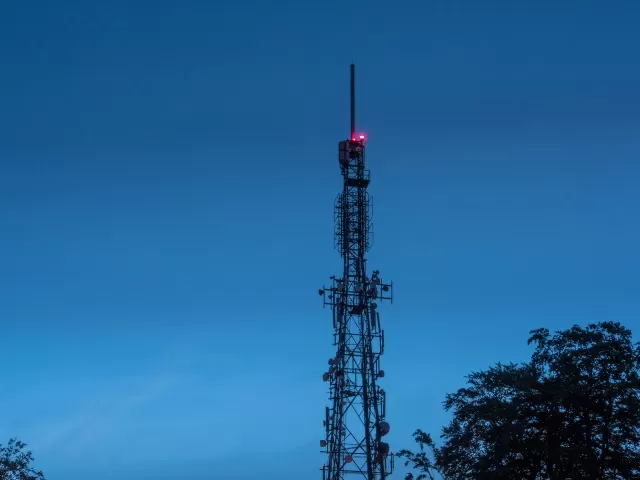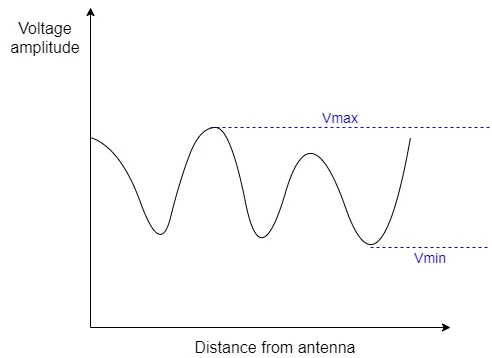Check out our White Paper Series!
A complete library of helpful advice and survival guides for every aspect of system monitoring and control.
1-800-693-0351
Have a specific question? Ask our team of expert engineers and get a specific answer!
Sign up for the next DPS Factory Training!

Whether you're new to our equipment or you've used it for years, DPS factory training is the best way to get more from your monitoring.
Reserve Your Seat TodayVoltage Standing Wave Ratio (VSWR) is a vital stat for transmitter sites.
For radio to deliver power to an antenna, the impedance of the radio and transmission line should be completely matched to the antenna's impedance. The measurement VSWR is a value that will report how well the antenna is impedance matched to the radio or transmission line it is connected to.
For this reason, VSWR should be measured and monitored at all times to allow you to detect (even act upon) an issue before it affects your network. So, you'll need an efficient remote monitoring system to give you visibility over your VSWR parameters. With in-depth insights about your VSWR, you can protect the strength of your infrastructure's connectivity.
In this article, we'll explore the concept of VSWR, as well as why and how you can properly monitor it.

VSWR stands for Voltage Standing Wave Ratio and it is a measure of how efficiently radio frequency (RF) power is transmitted from a power source, through a transmission line, into a load - for example, from a power amplifier through a transmission line to an antenna.
In an ideal system, 100% of the RF power is transmitted (1:1). This will require an exact match of impedances between the transmitter to the cable or antenna. The signal's AC voltage will see no interference (it will be the same from end to end) and no power is reflected.
However, in real-world systems, everyday items such as connectors or even bigger problems (such as a damaged antenna) can cause mismatched impedances. This means that some of the power will be reflected back towards the source (much like an echo).
Reflections cause destructive interference, which leads to peaks and valleys in the voltage at various times and distances along the line. In real-world RF components, a Voltage Standing Wave Ratio (VSWR) value that is deemed satisfactory typically falls below 1.5:1. By maintaining a VSWR under 1.5:1, engineers can ensure that the majority of the power is delivered effectively, minimizing inefficiencies and maximizing performance.
Put simply, VSWR is a ratio that measures the voltage variances between forward and reflected power.

In a nutshell, there are many reasons why VSWR should be paid attention to on a wireless transmitter site. Some of them are:
High VSWR can have several consequences on RF transmission systems. A significant impact is the reduction in power delivered to an antenna or system, which can lead to:
By understanding these potential issues, network managers can take proactive steps to ensure optimal performance and longevity of their RF systems. This dual focus on performance indicators and practical consequences provides a comprehensive view of how VSWR affects system integrity.
VSWR has an impact on through power so continuous monitoring allows trends to be seen. Without VSWR monitoring, the first time you hear of a problem may be from your end-users.
The most common way that VSWR is measured is when a tech is at the remote site to test equipment. Usually, this happens at the time of the initial install, when troubleshooting for an issue, or during annual preventative maintenance checks.
This approach of only checking on equipment if technicians are on-site disturbs the normal operation of the transmitter and its users during the test. It also leads to expensive truck rolls, don't provide performance trending reports and it only allows for reactive (and late) responses when an issue happens.
VSWR is really important and should be continuously monitored in order to perform proactive maintenance, respond to issues in a timely manner, and to have trend analysis reports. Fortunately, remote monitoring technologies can help you with that by providing complete visibility.
VSWR monitoring systems usually have the following components:

VSWR alarms occur when problems happen between the source and the receiver. These are usually problems involving the antenna, cables, or even the connectors that can negatively affect your network's performance.
Your VSWR monitoring alarm can indicate that a device's component is damaged, that a weather-related incident has happened, or that the frequency band supported by the RF unit is not consistent with that supported by the components of the antenna system. These alarms give you an additional layer of network protection because they provide you with troubleshooting real-time data - which is particularly important for large installations.
Usually, this VSWR data is not monitored. And it is only manually collected once a year during annual maintenance checks or after end-users have already been affected by network downtime.
To avoid these issues, the remote monitoring system of your choice should provide you with 24x7 custom alarm notifications through whichever method is best for you. This means never missing an alarm again.
VSWR monitoring systems allow you to identify issues in the efficiency between power sources and loads, for instance, amplifiers to antennas. With remote monitoring, these problems can be notified to a central location or directly to you in real-time. This makes it possible to act proactively and respond to issues in a timely manner, reducing system downtime.
There are some main benefits that you can get by monitoring VSWR. Some of them are:
With no remote monitoring of VSWR data, your technicians will not be able to determine the main reason as to why the communication system is losing efficiency. This might lead to time-consuming and labor-consuming troubleshooting - and issues are likely to get worse before they are spotted and dealt with.
With automated monitoring systems, network technicians are capable of easily identifying equipment failure. Meaning that they respond to possible damage in a timely manner while being able to maintain the network uptime.
Instead of having to drive to your remote sites whenever problems are suspected (even small problems), you can use your remote monitoring system to know for sure what's going on. Remote VSWR monitoring makes it possible for you to have detailed visibility of your network and to collect thorough information about any issues before sending your techs to the field. This means that they won't have to drive from site to site to try to determine that the issue is.
Also, if you invest in a remote monitoring system with control relays, this means that you'll be able to remotely control your equipment. Then, you'll only send your staff to expensive truck rolls when strictly necessary.
When problems are notified to you by your VSWR monitoring system, your techs can be dispatched with the right tools from the start. They won't need to drive back and forth to solve problems, and they will be able to make conscious decisions in order to troubleshoot.
This all leads to fewer hours of expensive windshield time and fewer hours at the remote sites.
Your expensive remote equipment, such as repeaters, antennas, duplexes, and combiners can all be protected with a monitoring system. It will use real-time information to identify and inform you about issues before they affect your network uptime.
If your personnel is not aware of critical VSWR alarms, your gear can become more and more defective over time, possibly becoming nonoperative. With a monitoring solution, VSWR can notify you about escalating issues, allowing you to solve them before they can evolve into network downtime.
An efficient remote monitoring system that has the right capacity (usually about 15% more than your current need) will allow your network to grow without the necessity of keep adding monitoring devices.
But also, as your remote network grows, it becomes more difficult to maintain and monitor large amounts of devices and equipment. So, investing in a multiprotocol master station makes it easier to keep an eye on all your of gear at once - in only one display.
Furthermore, instead of having to send your technicians to remote sites for regular maintenance checks and small inspections, you can have them check the network health through the integrated interface of your master station. This means that scaling up is going to be less expensive in terms of time and effort for maintenance.
In a nutshell, if you have transmission sites you need to monitor, Voltage Standing Wave Ratio (VSWR) is an important way to measure your overall efficiency. VSWR gives you an accurate value of radio-frequency power, as transmitted between RF power sources and into loads.
VSWR has a critical impact on through power, which can expose wireless voice and data systems to vulnerabilities if not monitored at all times. For this reason, having a remote monitoring system for your VSWR measurement makes it much easier for you to detect and solve problems in a timely manner - before end users get affected.
Also, with a remote monitoring solution, your technicians are able to more readily troubleshoot your network performance, taking into consideration the areas that need work the most. VSWR makes it possible for you to manage your deployments more efficiently, reducing your costs with maintenance - ultimately making better use of your staff's time.
But, all of this is only possible when you invest in a competent monitoring system. There are many aspects that will determine how effective your system is, but it all starts by working with the right vendor.
Not any vendor though, work with experts to achieve the best efficiency possible. And that's what we are. We're an experienced remote monitoring systems manufacturer and we've been in business for over 30 years.
We specialize in custom solutions that can fully meet your requirements. You'll be able to continuously monitor VSWR data, making it possible for you and your team to better manage your critical communications infrastructure.
Do you need a solution that will allow you to view past data to identify intermittent problems, that will alert to weather-related problems, and that will let you access and control devices remotely in an intuitive platform? If so, just reach out to us.

Andrew Erickson
Andrew Erickson is an Application Engineer at DPS Telecom, a manufacturer of semi-custom remote alarm monitoring systems based in Fresno, California. Andrew brings more than 19 years of experience building site monitoring solutions, developing intuitive user interfaces and documentation, and opt...